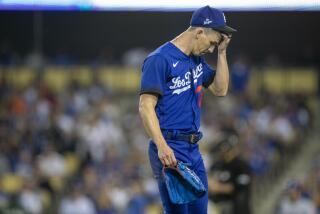Dusting Off an Old Rule of Pitching
Branch Rickey called it the purpose pitch.
The guys on the schoolyard used to call it the beanball.
The polite term is the brushback, but Leo Durocher used to just holler, âStick it in his ear!â
They like to tell you that the best pitch in baseball is the fastball, and it usually is. But any major league hitter with his heels dug in, his back foot planted and his bat at the ready can handle 80% of the fastballs thrown his way.
Any major league pitcher knows that. So, his job is to see to it that the batter doesnât get his heels dug in, his feet planted.
Dizzy Dean once watched in growing irritation as a rookie batter dug in meticulously at the plate, throwing up dirt like a dog hiding a bone, holding his hand up to stop play until he got balanced. Dean finally inquired, icily: âAre you through?â
When the kid nodded, Dean had some advice: âWell, you better keep going till you get six feet down and then get a lily because if you dig in like that against me one more time, thatâs where theyâre going to bury you.â
Pitchers like hitters on their tippy-toes, poised and ready to leap out of the way like a Nijinsky. Anything else is a slur on their manhood--or their fastball.
Perhaps you were paying attention in the recent All-Star game to an outstanding example of a major league pitcher protecting his turf. The circumstances were a bit unusual for National League pitcher Nolan Ryan that day. In the first place, the ballpark was what you might classify as snug. In the second place, 33 home runs had been rocketed out of it in a home-run contest the previous day.
Ryan, of course, has no reputation at all as a control pitcher. His fastball is well known to be in the homicidal range.
So, pitching in the bottom of the fifth inning with a 4-1 lead and runners on base, Ryan did not want the dangerous Rickey Henderson of the Yankees to get into his home-run crouch.
The pitch came in high and tight and 90 m.p.h.
Henderson did what he would do if he spotted a runaway truck. He did a perfect one-and-a-half back flip, getting out of the way just in time. Then he got up, dusted himself off and struck out on the next pitch--which was, of course, down and away.
Later in the game, Ryan found himself similarly facing home-run hitter Dave Winfield, also a Yankee, with runners on base and two out. Again, the pitch whistled high and close, so close it ticked off Winfieldâs bat as he was falling to the ground. Winfield got up and grounded weakly to the second baseman.
There were, it is interesting to note, no home runs hit that night in that confining park.
Nolan Ryan has no established reputation for head-hunting. But he has one for walks, having dispensed more than 2,000, the most in major league history, and for wild pitches, 21 in one season once and the league lead in wild pitches three different years. No one wants his feet stuck in a hole when Ryan lets go of the ball.
The territorial squabble between pitcher and hitter is the secret war of baseball. Itâs a pitcherâs job to keep that hitter as deep in the batterâs box as the umpire will allow.
A batter who is able to stride forward and hit into a curveball before it breaks, or a batter who hangs over the plate looking for an outside pitch, is a humiliation for a pitcher. Shows him no respect. His job is to instill that respect.
Legend has it that the great pitchers of yore never had to resort to purpose pitches.
To be sure, the great Sandy Koufax holds the record for hitting no batsmen in a whole season, 41 games and 323 innings. But the baseball fable that the great Walter Johnson wouldnât risk hitting a batter for fear he might kill him wonât compute. The Big Train hit more batters than any other pitcher who ever lived--206 in his career of 20 years. Hall of Famer Don Drysdale hit 154 in 14 seasons.
Fear strikes out is more than just the title of Jimmy Piersallâs autobiography. Itâs a baseball truism.
Robin Roberts was one of the greatest right-handed pitchers of all time. He went into the Hall of Fame on the first bounce, won 20 or more games six times in a row. But the baseball word on Roberts was that he was âalways right around the plate.â As opposed to some who were always right around your head.
Roberts allowed 502 home runs in his major league career. Eight years in a row, he allowed 30 or more home runs, and he once allowed 46. He also led the league in hits allowed for five consecutive seasons. Robertsâ rules of order were impeccable. He won well within the rules. Not all do.
The batters well understand the other, unwritten rules of the battersâ box. âThe pitcher can hit you if he wants to,â Hall of Famer Lou Brock once put it flatly after a game in which he had hit the dust more than once under a high hard one.
Thatâs not really the point. The pitcher doesnât want to hit you. He just wants to make darn sure you donât hit him.
More to Read
Go beyond the scoreboard
Get the latest on L.A.'s teams in the daily Sports Report newsletter.
You may occasionally receive promotional content from the Los Angeles Times.










